April 2023 News

DB ICE 9568 (on 07.38 Mannheim – Paris Est) overtakes 185 557 on ÖBB Nightjet 468 (19.46 Vienna – Paris Est) as it comes off the LGV Est at Vaires on the approach to Paris on Sunday 19th March. Leased from MRCE, 185 557 was the final 185.0/185.1 series Bombardier TRAXX to be completed in 2006 after a product run of 332 locomotives. Photo: Christophe Masse
€100 billion New Deal for rail
Renewal and rehabilitation of the rail network are key aims of a long-term investment plan announced by Prime Minister Elisabeth Borne on 24th February, to make rail the backbone of a climate-friendly country-wide transport network by 2040. Spending of up to €100 billion is pledged to reverse the degradation of main line and secondary routes, whilst continuing investment in LGV, the overnight passenger network and development of lower-cost operations for rural lines.
The strategy, whose major elements will be announced in June, has been selected from three put forward by the Conseil d’Orientation des Infrastructures in its review of rail policy and funding. The Planification écologique aims to double rail usage in urban areas, with at least €1 billion for RER-style service in each of a dozen cities. Other projects are being developed with the régions to upgrade and raise capacity of secondary lines to make rail a better alternative to the private car. Funding for these will include a local element yet to be agreed, plus money from EU sources and from aviation taxes and autoroute tolls.
Though few specific schemes were mentioned, a further €2 billion has been allocated to accelerate the POLT upgrading scheme (see below), and an €81 million modernisation of Woippy marshalling yard at Metz was announced on 2nd March during a visit by Transport Minister Clément Beaune. It was also expected that Lille would be chosen as the first city for development of an RER. Detailed studies for these new RER networks are to be undertaken by Société du Grand Paris as project promoter.
More money for POLT upgrade
Maire Lombertie, who is vice-president of the pressure group Urgence Ligne POLT, warned that years of late-running and cancellations risked damaging the economic prospects of the vast area of central France served by the line.
Group Legrand, the major electrical equipment manufacturer based in Limoges, had already complained to SNCF of the effect that poor connectivity was having on its business, while others were reported to be considering leaving the city. Several rail users’ associations are also petitioning for the upgrade to be accelerated as part of wider proposals to reduce desertification in the Massif Central, where secondary lines connect with POLT trains at Brive-La-Gaillarde.
Opposite. The 07.40 Toulouse – Paris Austerlitz headed by BB 26073 waits to depart from Limoges in September 2019.


Class 77 DE 6310 F heads through Toulouse-Montaudran on the 27th February with Régiorail train 76666 conveying clinker from Sète to Tonneins. Originally ordered and numbered DE 6310 F by Crossrail, it was bought by Akiem in 2011 and leased to VFLI as 77504, before being taken over by Régiorail. Photo: Georges Turpin
Climate test chamber opens
Together with the existing facility at Alstom’s La Rochelle plant, the new chamber will help reduce French vehicle manufacturers’ use of foreign test centres. Primarily for testing Alstom products, the new facility is also likely to be offered to automotive and defence equipment manufacturers.
CEF was created in 2000 to provide test facilities for urban rolling stock and their automation systems.The principal shareholder is Alstom (96.1 per cent), with the remainder held by the railway certification agency CERTIFER (Agence de Certification Ferroviaire).
Photo: Alstom

The site at Petite-Forêt provides facilities for testing urban, suburban and light rail rolling stock. It has a circular 110km/h test circuit, with twisted track and a range of curves for testing tyre wear. It is also equipped with ERTMS and can handle fully automated trains. The test circuit offers a range of energisation; catenary : 25kV (50Hz/60Hz), 15kV (16Hz⅔), 3000V, 1500V & 750V and lateral rail : 750V.
CEF operates a second site (CEF2) at Trouville-en-Barrois, near Bar-Le-Duc. A 12km straight test track designed for testing main line and freight rolling stock at speeds up to 160km/h with 25kV (50Hz) or 1500V energy supply. It also includes a shunt testing facility.
CEF operates a second site (CEF2) at Trouville-en-Barrois, near Bar-Le-Duc. A 12km straight test track designed for testing main line and freight rolling stock at speeds up to 160km/h with 25kV (50Hz) or 1500V energy supply. It also includes a shunt testing facility.
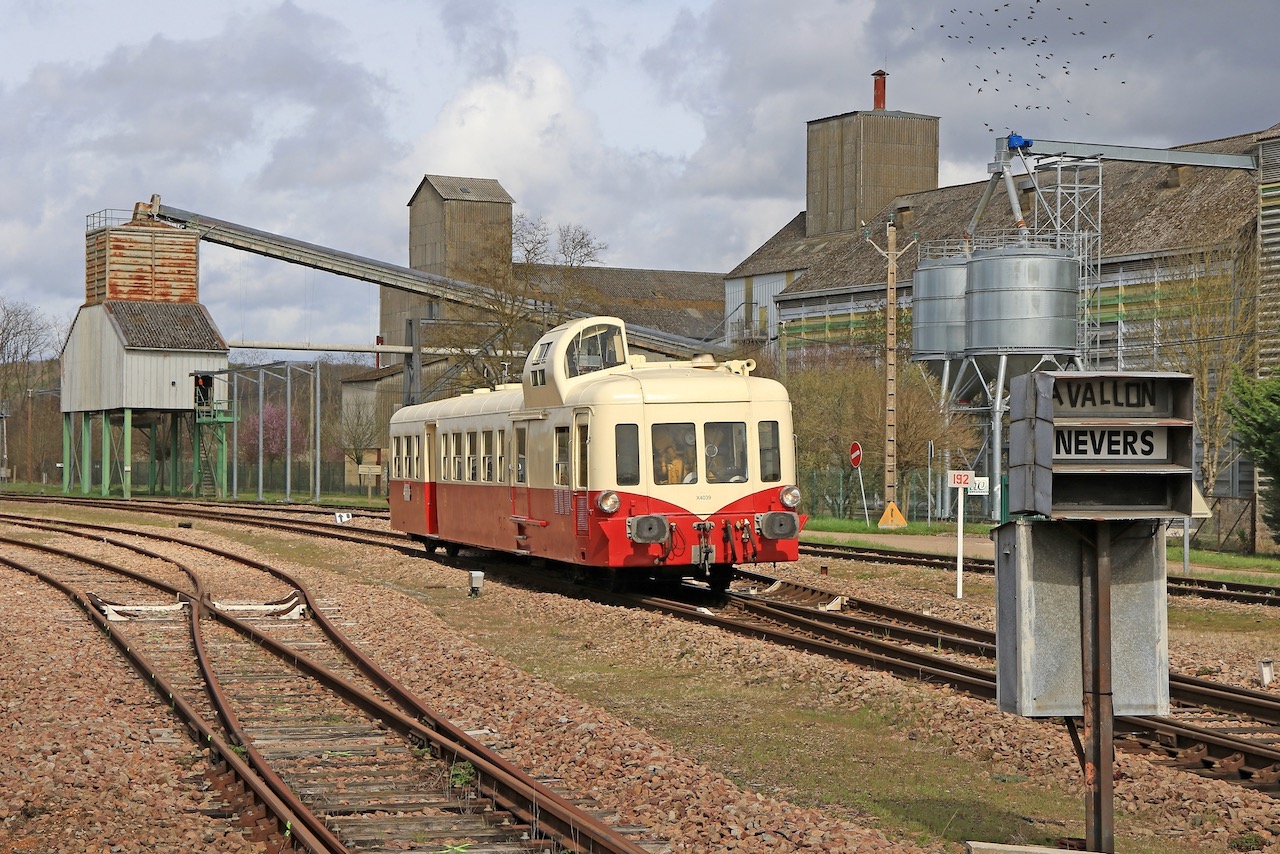
X 4039 Tour du Morvan
On Saturday 25th March ABFC (Autorails de Bourgogne Franche-Comté) ran its Tour du Morvan with X 4039, the only Picasso registered to operate on the French network. Leaving Dijon X 4039 headed north to Laroche-Migennes where it turned south to Cravant-Bazarnes taking the south-east fork to Avalon. Returning to Cravant-Bazarnes X4039 then headed down the other side of the fork to Corbigny before re-tracing its steps to Laroche-Migennes and Dijon.
At the beginning of February the Préfet of Côte d’Or pronounced ABFC's Picassos (X 3886 and X 4039) Monuments Historiques following the recommendation of the commission régionale du patrimoine et de l’architecture. ABFC will now be entitled to financial support to help maintain the two autorails, that have now spent more time in preservation than in regular service.

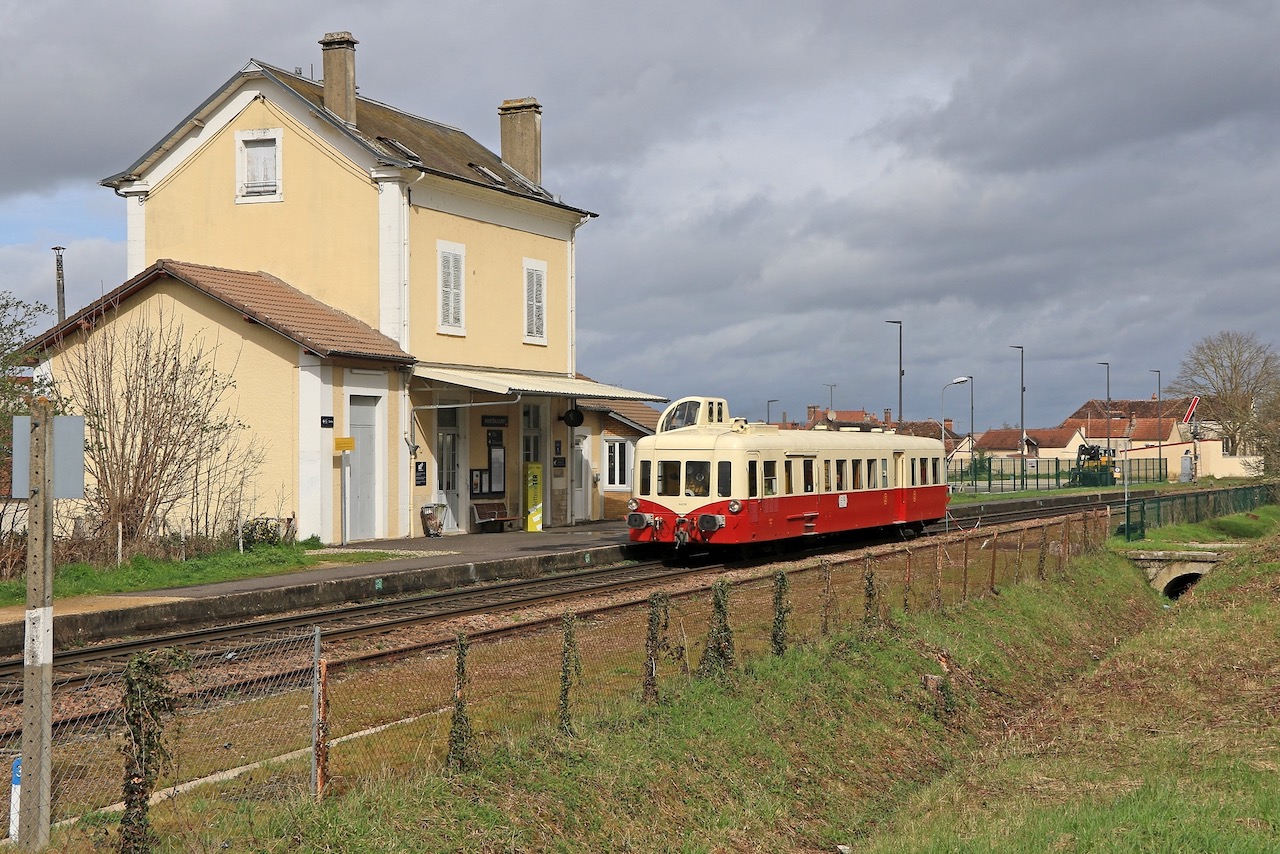
Montpellier – Béziers LGV moves forward
Construction is not expected to start before 2030 for opening in 2034. Costed at €2 billion, the project will be financed by the State and Occitanie Région (40 per cent each), with the remainder coming from local sources. The project has faced considerable opposition in the département of Hérault where the alignment will run on viaduct close to the ecologically-fragile Bassin de Thau.
Phase 2, envisaged for completion by 2040, will see construction of a further 121km to link with the Perpignan – Figueres LGV opened in 2013. There will be new TGV stations at Béziers Est and Narbonne Ouest. Part of this section will also be designed to carry freight trains.
Phase 2, envisaged for completion by 2040, will see construction of a further 121km to link with the Perpignan – Figueres LGV opened in 2013. There will be new TGV stations at Béziers Est and Narbonne Ouest. Part of this section will also be designed to carry freight trains.

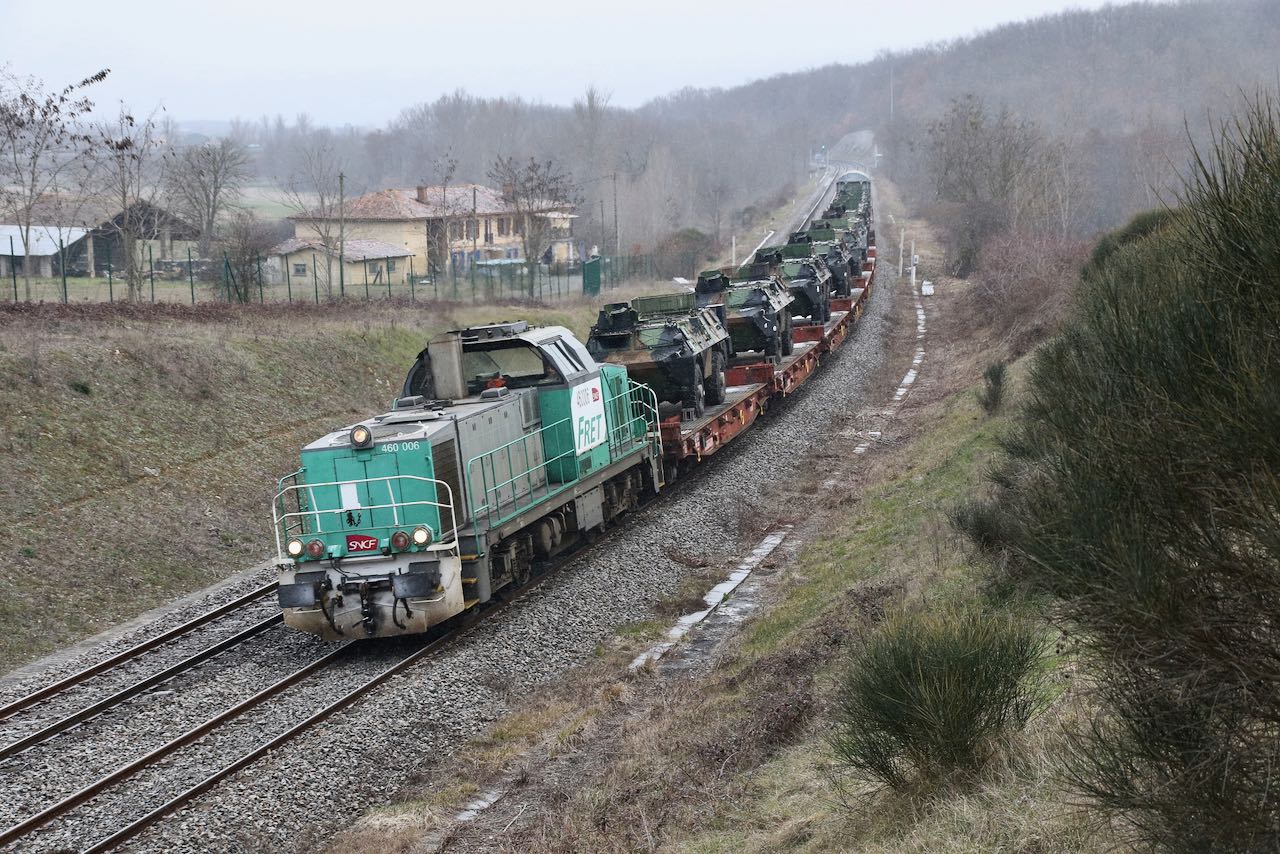
Military on the move
After a layover at St Jory Yard oil tankers were attached and the train proceeded to Miramas behind BB 26105, seen opposite passing through Toulouse-Montaudran. Photos: Georges Turpin

Beaucaire freight terminal re-vitalised
After an absence of eight years, rail traffic will return to the Domitia industrial zone in Beaucaire, near Arles. The principal user will be Arterris a cereals co-operative. Over the last two years Arterris, Compagnie Nationale du Rhône and the Community of Beaucaire Terre d'Argence municipality have spent €360,000 upgrading the track work and Arterris have overhauled its shunter that hasn't operated for ten years.
The site has three silos with capacity for 75,000 tons of cereals. Arterris anticipate operating twenty trains this year, each 1,500 ton trainload replacing 50 lorry journeys. The principal flow will be 25,000 tonnes of durum wheat to the Panzani pasta plant in Marseille.
Railcoop opts for one-way service
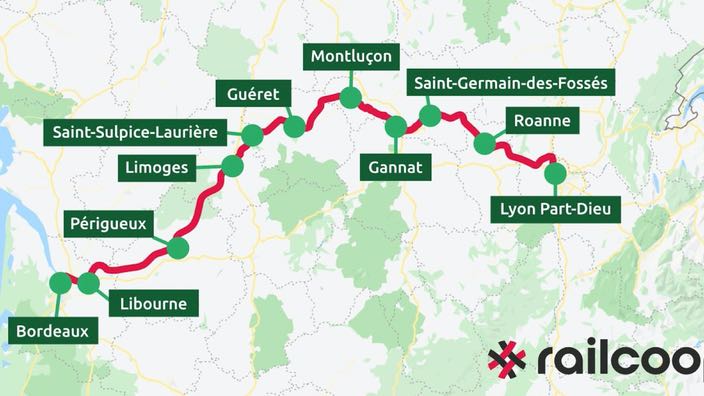
At the Railcoop general assembly at the end of February, members voted to start the long-planned Bordeaux – Lyon service in summer 2024 on the basis of running in each direction on alternate days, providing three return services a week.
Described as a more sober start than originally envisaged, Railcoop has been constrained by lack of funding from banks and financial institutions. It is now raising €4.1 million in shares and equity securities to meet start-up costs that include purchase of a second X72500 three-car unit. The existing two-car set will be used for spares while the three-car units receive a light overhaul by ACC M of Clermont-Ferrand before entering service. The X72500s are over 20 years old and have averaged about 2 million km with SNCF so will need a major mid-life refurbishment in the near future.
On the freight side, Railcoop began operating a second freight service on 29th March to Gignac-Cressensac, between Brive and Souillac in addition to its Capdenac – St Jory – St Gaudens service.
241 P 17 boiler re-certified

The four year overhaul of 241 P 17 has been successfully completed. Over the weekend of 24th/26th February the locomotive was lit up for the first time since 2018. On Sunday 26th boiler pressure was increased to 20 bar with only a slight leak from the regulator valve. This was followed on 3rd March with a further live test when the ten year boiler certificate was granted. A loaded test run was scheduled to take place in March.
The 2023 programme for 241 P 17 will begin on 22nd April with short trips from Le Creusot to Chagny and Étang-sur-Arroux followed by an appearance at the AJECTA Festival Vapeur on 6-8th May.
Music to their ears
In an effort to reduce the 2,500 hours of delay per year caused by trains hitting animals, SNCF has experimented with a system of lineside loudspeakers installed between Dijon and Bourg-en-Bresse. Like the scarers used at airports, these broadcast sounds of a hunt in full cry 30 seconds before the passage of a train so as to scare animals away from the line.
The trial, which has cost €170,000, is expected to lead to a reduction in damage to rolling stock and to the stress caused to staff who have to remove animal carcasses from the track. The daily average of five animal-related collisions costs SNCF several millions of Euros annually in rolling stock repairs and delay-reimboursements.
SNCF retains Amiens local services
Despite concern over recent cancellations and delays, SNCF Voyageurs has won the tender launched by Hauts-de-France region for operation of local TER services from Amiens. Transdev was the only other bidder; it is reported that the competition resulted in SNCF Voyageurs significantly lowering its price, offering to run more trains and promising a high rate of punctuality.
The new contract will start in 2024 and run for nine years. It requires SNCF to increase service provision by 9.5 per cent with a punctuality rate of 98.5%; viewed by commentators as extremely ambitious. Failure to meet these conditions will result in financial penalties or cancellation of the contract without compensation.
The president of L’Association Française du Rail (AFRA) has warned that it is important for SNCF do not win all the tenders if a competitive environment is to be maintained and private operators are not discouraged. Out of three calls for tender launched by the regions for their TER services, SNCF Voyageurs has so far won two and Transdev one. The next results are expected in the summer for Pays-de-la-Loire and Ile-de-France.
Next year the contract for the operation of services between Amiens and Paris will be tendered; this is attracting a wider range of interest.
Euskotren increases capacity

Euskotren, operator of the metre-gauge cross-border line from Hendaye and Irún to Donostia-San Sebastián, has taken delivery of the first two of four CAF Class 940 electric multiple-units. Ordered in 2021 at a cost of €32 million to meet growing demand, the air-conditioned four-car units are equipped with toilets and each will carry 400 passengers with 120 seated. The new trains will enter service this summer on Euskotren’s E2 half-hourly interval service from Hendaye to San Sebastián and Lasarte-Oria. It is now the only cross-border passenger service as neither SNCF runs to Irun or RENFE to Hendaye any longer.
Major infrastructure investment is taking place to increase capacity, including construction of a 4.2km three-station cross-city underground line in San Sebastián to replace the need for through trains to reverse at the current Amara terminus. Opening is scheduled for 2024.
An €11.3 million contract has recently been awarded for modernisation of the underground Anoeta station adjacent to the Reale Arena stadium (home of Real Sociedad) in San Sebastián. This will include lengthening the platforms, replacing the street-level station building and providing a second entrance.
Big recruitment drive under way
Recent changes to working conditions and retirement schemes have made both operators less attractive to new recruits. In addition, the unsocial hours demanded of staff, particularly by RATP, are now seen to be inadequately recompensed. RATP continues to be affected by the fallout from covid, with high levels of absenteeism and resignations. The need for 1,100 new metro staff, including 400 train drivers, is dwarfed by the shortage of some 2,700 bus drivers and 400 maintenance staff.
Z 600 farewell
SNCF has withdrawn the last of the Z 600 automotrices built in 1958 by Decauville-Oerlikon for the Saint-Gervais-les-Bains-Le Fayet to Vallorcine metre-gauge third-rail electrified line known as Mont-Blanc Express. Along with four trailers, they provided the service until Z 800 two-car sets arrived in 1996. These and the later three-car Z 850 three-car trains are equipped with pantographs for through running to Martigny in Switzerland. Cars 602, 604, 606 and 608 were withdrawn between 1996 and 2009; Z 603 was converted into a flat car and the remaining three confined to works trains. These were withdrawn at the end of last year when automotrice ABDeh 4/4 No 4 was acquired from the Martigny – Châtelard Railway, renumbered by SNCF as Xemh 4/4 No 4.
Tarbes reopening delayed
Citing a long list of woes, SNCF Réseau announced on 8th March that reopening of the Tarbes – Montréjeau – (Toulouse) line, scheduled for 1st April, would be delayed by four weeks. Major infrastructure work has been in progress since 17th October (see November News).
Despite months of planning and mobilisation of equipment, materials and staff, the work has been plagued by breakdowns, shortages, cable theft, vandalism, poor weather conditions, absenteeism and strikes. Extra staff drafted in from mid-February and measures put in place to accelerate the work have been insufficient for the planned reopening date to be achieved.
Buses will continue to ferry passengers to and from Tarbes, Lannemezan and intermediate stations, connecting with Toulouse trains at Montréjeau.

There are also fast Toulouse – Tarbes buses as well as a non-stop Toulouse – Pau – Bayonne service replacing the Intercités.
Photo: Melting Film
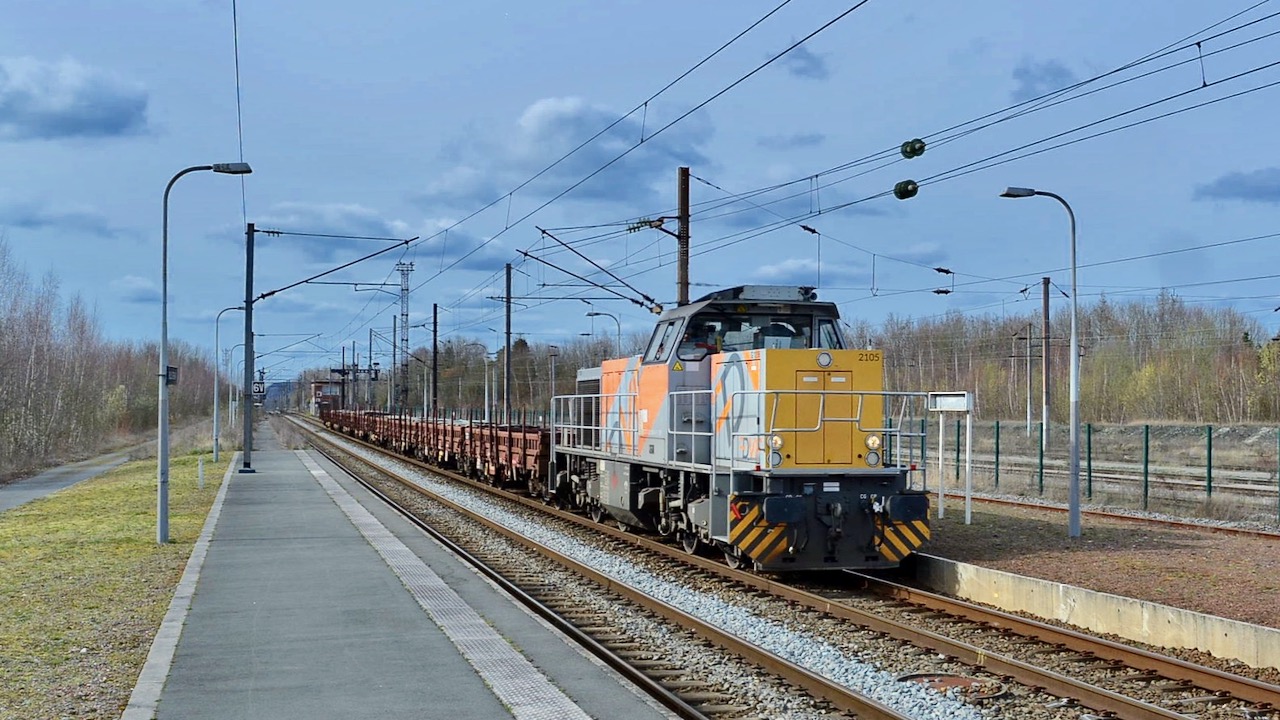
Vossloh G 1206 2105 (works number 5702105) operated by track maintenance company Dijonnaise de Voies Ferrées heads through Bully-Grenay on 15th March with a Dunkerque – Loison-sous-Lens engineers service. Photo: Philippe Armand
Combrail out of business
SFLF owns some 150km of disused railway in the départements of Puy-de-Dôme, Haute-Loire and Loire, principally between Pont-de-Dore and Darsac in the Parc Naturel Régional Livradois-Forez, maintained for leisure purposes and for freight movement. Combrail had been asking SFLF to carry out improvements since 2017 and had commissioned at its own expense a report into the state of the track.
Expenditure of €47 000 by Papeteries de Giroux permitted traffic to continue until 1st June 2022, but further operations were halted on safety grounds by préfectorial decree. No further funding has been forthcoming from local sources or Auvergne-Rhône-Alpes région. As a result, traffic between the two plants has reverted to road.
Opposite: The layout at Giroux in January 2019. Photo: Roger Allen

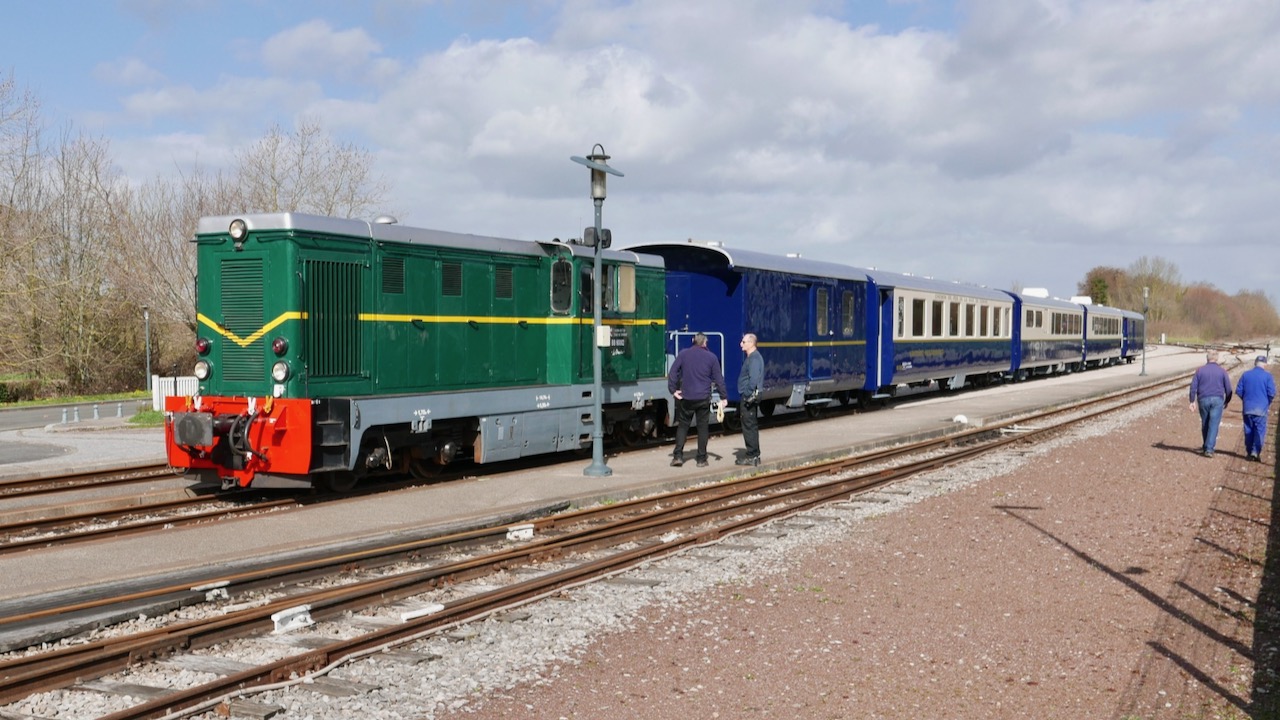
On Monday 13th March the new CFBS Quatre Saisons dining train had its inaugural run from St Valery to Le Crotoy, seen above during the run-round at Noyelles. The former Rhätische Bahn kitchen car flanked by a dining car (with servery) and an open saloon will offer year round dining and have capacity for 100 diners. Along with the fourgons they have undergone a five year overhaul and conversion by CFBS volunteers. In addition to a complete re-paint, new double glazed windows and internal renovation major changes were made to the electrical system converting it to operate from the RhB 11 kV AC overhead supply to current supplied by the on-board generators located in the fourgons. Other alterations include the braking system, making it compatible with CFBS locomotives as the gradients of the Baie de Somme require less braking capacity than the Swiss Alps. The new dining train will undergo a series of trials and working up before entering commercial service in the autumn. Photo: Maurice Testu
Urban rail news
Citadis X05 tram for Nantes
Nantes Metropole’s new-generation tram was unveiled at Alstom’s La Rochelle plant on 13th February. The Citadis X05 will gradually replace Métropole’s first-generation trams which are now approaching 40 years old. A total of 61 were ordered in two batches in 2020-21; the first 14 are due for delivery by the end of 2024 and will run on Line 1.
The seven-section trams, which have been designed with input from Nantes residents, will carry a maximum of 300 passengers. They have automated door-opening to help keep the interior warm in winter. Sensors will recognise approaching passengers and open doors automatically.
Fourteen of the new trams are earmarked for operation of the future Lines 6 and 7, under construction for opening in 2027.
First GPE interior designs
Two days later, interior designs were unveiled for the 37 automated trains that Alstom will build for Grand Paris Express metro Line 18. Developed by Alstom’s Advanced & Creative Design office in collaboration with Ile-de-France Mobilités, SGP and Egis Rail, manufacturing is to begin at the Petite-Forêt works later this year. The first trains are scheduled to enter service from 2026.
The three-car trains will be 47m long with a capacity of 350 passengers. Interior lighting will adjust to the time of day, and there will be air-conditioning, wi-fi, USB sockets, CCTV and passenger information screens.

Each car will have three 1.65m wide doors, with wide aisles to ‘give a spacious feeling and allow a greater flow of traffic’ according to Alstom. The gangways will have a rigid lining instead of the traditional bellows. Centre cars will have dedicated luggage space as Line 18 will serve Orly airport.
Caen La Mer
Work on Caen's fourth tram line, linking the west side of the city, is scheduled to start in 2025 for completion in 2028. The opportunity will be taken to remove the overhead catenary on the existing network between the stops at Bernières and the Place de la Mare improving the views around the Saint-Pierre church and the Chateau. On the new fourth route it will be between the Theatre and rue Caponière, and on avenue Albert Sorel, benefiting the Abbaye-aux-Hommes and the Lycée Malherbe. The 26 existing Alstom Citadel trams will be modified and the ten new trams will be equipped with roof-mounted batteries to operate through the non-energised zones.
Toulouse
Toulouse transport authority Tisséo has awarded the Eiffage/NGE consortium a €233 million contract for civil works on the Colomiers – Laporte section of the automated metro Line C. Designated Lot 1, this includes 3.9km of tunnel, three stations and ancillary structures such as connecting shafts. This follows award to the consortium of the €589 million Lot 2 contract (see March Newsitem).
CAF Bagnères to specialise in trams
Bagnères-de-Bigorre is to become CAF’s tramcar centre of excellence Director-General of CAF France Alain Picard announced in an interview with La Dépêche du Midi last month, allaying fears that the recent transfer of work to the former Alstom plant at Reichshoffen in Alsace would be detrimental to the site in Hautes-Pyrénées. While Bagnères would have less work in 2023 than originally planned, the plant is currently turning out locotractors for RATP and renovated RER Line A cars. Construction of trams for Marseille and Montpellier would start in March 2024 and personnel increase from 120 to 200.
Picard referred to the rapid growth of CAF’s order book, currently €13 billion, of which about 20 per cent was for French customers, and to the strength of the world market for trams and light rail vehicles. He also mentioned the difficulty of recruiting in Hautes-Pyrénées, where CAF competes for staff with Alstom at Tarbes as well as local aerospace and tech industries.
The news is a blow to plans for reopening the Tarbes – Bagnères line, the case for which rests strongly on its potential use for movement of completed heavy rail vehicles in and out of the plant. Tramcar sections are more easily handled by lorry than complete coaches.
Turning back the clock
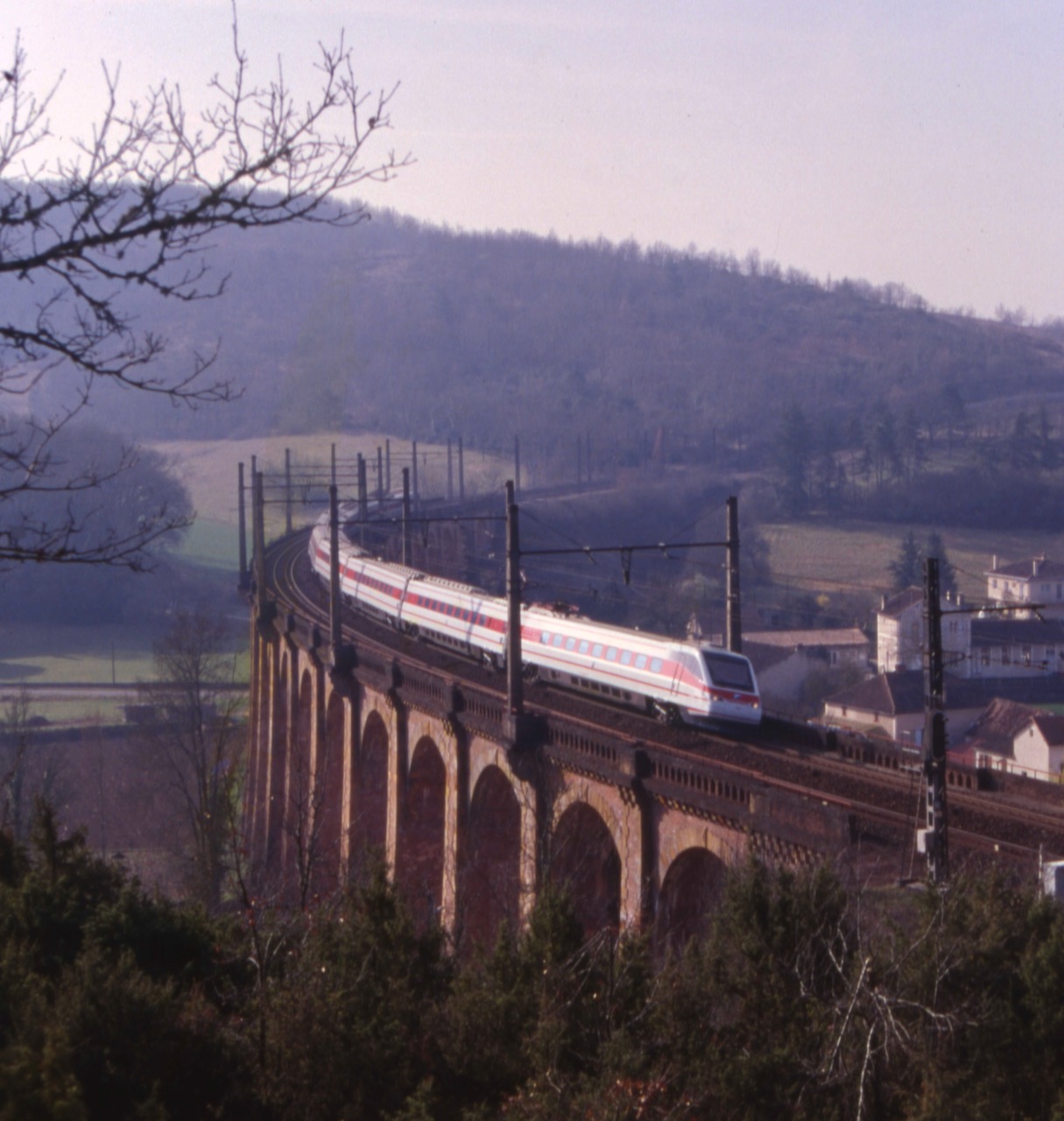
Between 1997 and 2002 SNCF undertook a series of trials with tilting trains on the Paris – Limoges – Toulouse line with the aim of speeding up journey times on the tortuous section south of Limoges. Trialled were TGV PO1, RTG Axis and the Italian ETR 460. The latter is seen above crossing the Viaduc du Calamane, north of Cahors in March 1997, during four weeks of trials between Paris and Toulouse. Photo: Georges Turpin
In January 2002 it was the turn of newly-built Virgin Voyager Class 221 101, then with its 6 degree tilt, that made a series of trial runs between Cahors and Brive. It is seen below in appalling weather on 18th January 2002 crossing the Viaduc du Boulet between Souillac and Brive, and opposite at Cahors on 30th January 2002 with three Quercyrail autorails. Photos: Christian Hospital

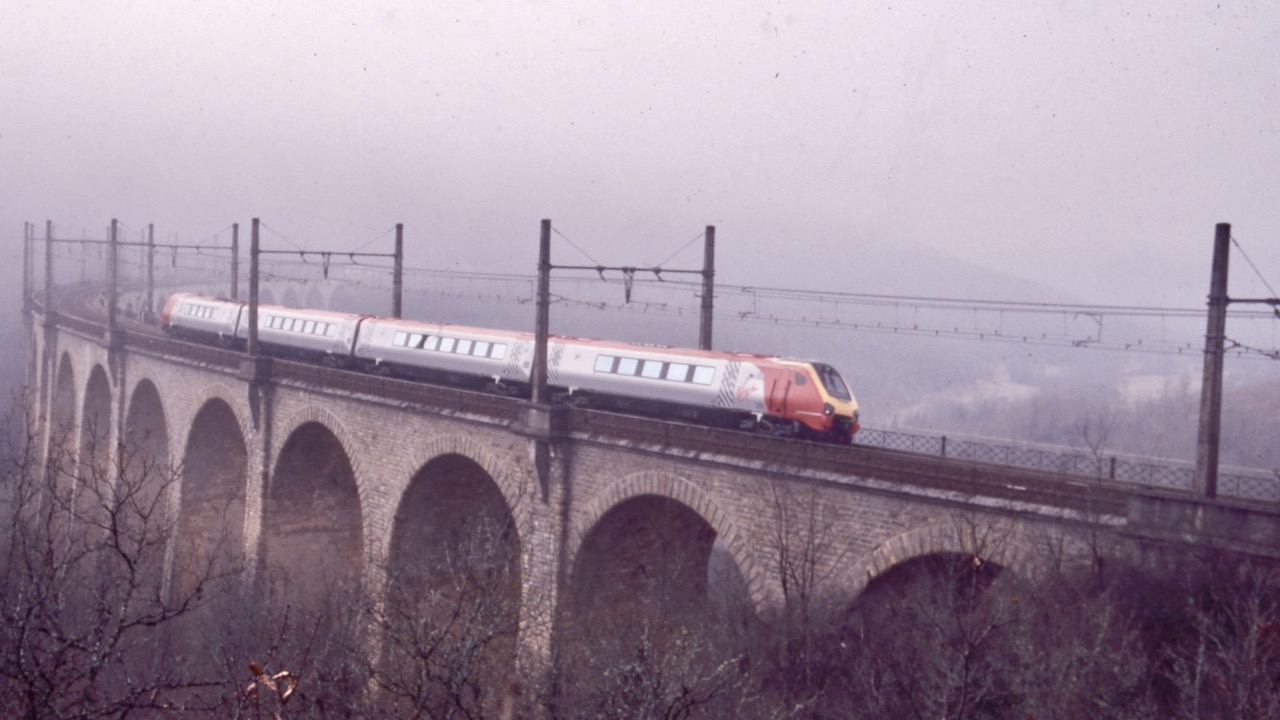
Additions to FRS Photographic Archive during February & March 2023
Additions to Folder 1
- A new gallery of colour photographs by Michael Whitehouse
To Locations section
- “Le Mistral” - LVDR 1210/1969
- TGV Sud-Est - LVDR 1499/1975
- Uniforms - LVDR 1504/1975
- Corse - LVDR 1536/1976
Additions to the FRS public folder during February 2023
Photographic index for Patrick Whitehouse gallery


Railtour update
Le Train Historique de Toulouse has announced a further tour with 141 R 1126 from Toulouse to Albi on Saturday 15th April, prior to its appearance at the AJECTA Festival Vapeur in May. Further details via this link
MFPN, operator of 231 K 8 and CC 40110, has announced a programme of tours for 2023 using alternative vintage traction.
- Saturday 27th May: (originally 13th May): Gare du Nord – Le Tréport hauled by BB 69432.
- Saturday 10th June: St Lazare – Rouen for the Special Armada hauled by BB 17016.
- Saturday 8th July: Gare du Nord – Noyelles for CFBS hauled by BB 69432.
- Saturday 10th December: Gare du Nord – Amiens for Christmas market hauled by BB 69432.
Further details via this link
Pacific Vapeur Club (PVC) (PVC) has announced three tours from Sotteville-les-Rouen. 231 G 558 is not expected to return to service this year as the boiler is still at CITEV Saint-Jean-du-Gard. The first tour will be to Le Tréport on 26th August then to Lille for the Braderie on 2nd September. The annual trip to the Herring Festival at Dieppe follows on 18th November. Traction is expected to be BB 17016 for Lille and BB 67400s for Le Tréport and Dieppe.
Further details via this link

Train à Vapeur d'Auvergne. With 141 R 420's major overhaul still ongoing the following diesel hauled programme has been announced:
- Saturday 13th May: Clermont Ferrand -- Du Puy-en-Velay
- Saturday 10th June: Clermont Ferrand -- Cosne-sur-Loire.
- Saturday 23rd September Vichy -- Neussargues -- Langeac -- Vichy
- Saturday 9th December Clermont Ferrand -- Lyon Perrache
TRAINS TOURISTIQUES DES GORGES DE L'ALLIER will again be operated by Train à Vapeur d'Auvergne running between Clermont Ferrand and Langogne on the following dates: 12th/19/26th July, 2nd/9th/16th/23rd August.
Further information via this link
AAATV at Les Aubrais (Orléans) has announced the following programme with 141 R 840 and 141 R 1199 potentially available for the steam-hauled tours and A1A A1A 68540 for the diesel trips.
- Saturday 24th June: Les Aubrais -- Paris Austerlitz (steam)
- Saturday 5th August: Les Aubrais -- Cosne-sur-Loire for château fort de Guédelon (steam)
- Saturday 16th September: Journées Européennes du Patrimoine open day at Les Aubrais with diesel hauled trip to Pithiviers.
- Weekend 7/8th October: Les Aubrais -- Arachon (diesel)
- Saturday 28th October: Les Aubrais -- Pithiviers Halloween trip (diesel)
- Weekend 16th/17th December: Les Aubrais -- Bourges/Tours Trains du Père Noël (steam)
Further information via this link
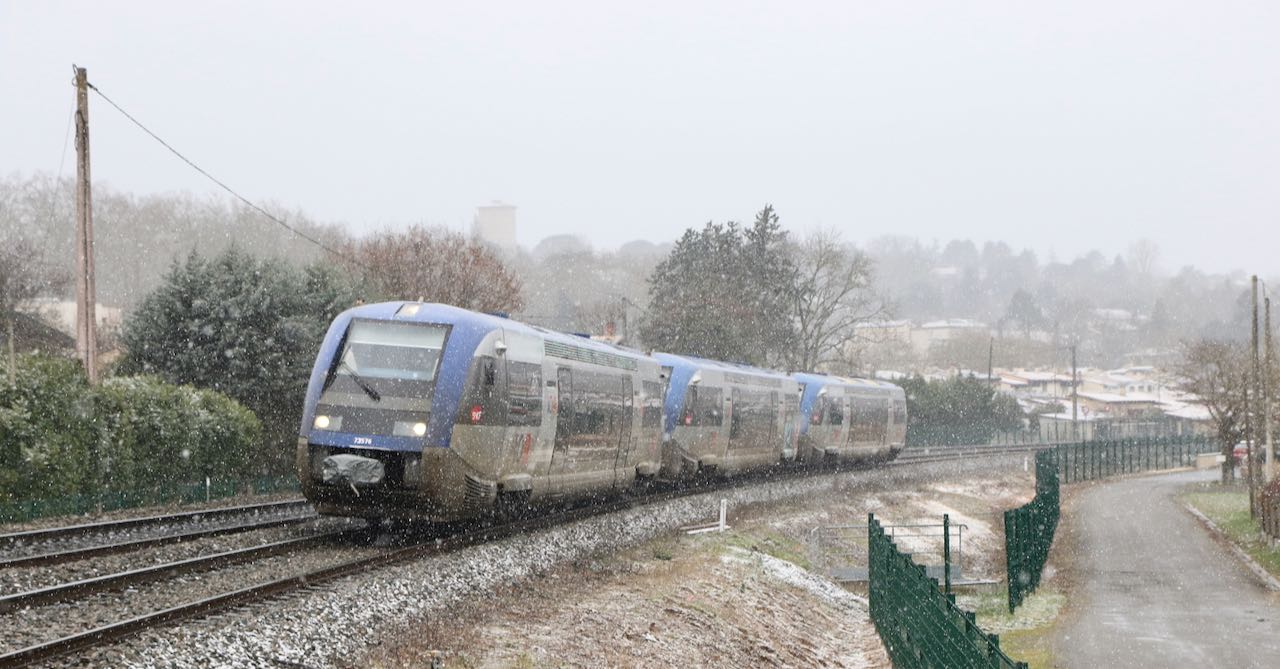
Winter farewell in Occitanie. On a freezing 27th February X 73576 leads a string of saucisses at Montrabé forming TER 870050 09.17 Toulouse – Carmaux. Photo: Georges Turpin
© Peter Lovell & Chris Bushell. The French Railways Society 2023. With thanks to Georges Turpin, Christophe Masse, Christian Hospital, Maurice Testu, Roger Allen and Philippe Armand.
